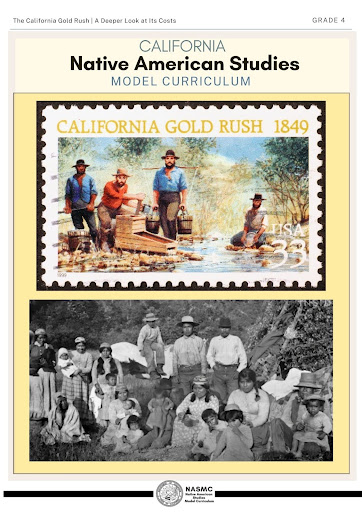Overview
Free Resources!
The California Gold Rush: A Deeper Look at Its Costs Unit

Authors: This unit was researched, authored, and edited by the California Indian Museum and Cultural Center, California Indian Education for All, and the San Diego County Office of Education. Key writers and researchers of this unit are Nicole Lim, Jayden Lim, Ramiro Medina, and Dr. Staci Block. The unit resources were designed and created from funding through the California Department of Education’s Native American Studies Model Curriculum grant and contract.
Grades: 4-5
Suggested Amount of Time: 60 minutes
Curriculum Themes:
- History
- Relationship to Place
Lesson Activities:
- The California Gold Rush – Uncovering the Costs
- Understanding How the Gold Rush Affected Native Americans in California
- Cause and Effect of the Gold Rush
- Imagine Life During the Gold Rush
- Gold Rush Reflection
Learning Goals
- Understand the California Gold Rush and its significance in U.S. history.
- Analyze the environmental and cultural impact of the Gold Rush on Native American communities.
- Discuss the consequences of westward expansion, including the exploitation of natural resources and displacement of California Native American peoples.
Lesson Overview
This unit examines the California Gold Rush and its lasting significance in U.S. history, with a focus on its environmental and cultural impact on California Native American communities. Students will analyze the consequences of westward expansion, including the exploitation of natural resources and the widespread displacement of California Native peoples. Through critical inquiry, the unit encourages students to understand the broader consequences of the Gold Rush and reflect on its role in shaping California’s past and present.
Historical Trauma Advisory
Please note that some material and linked resources in this guide contain graphic and distressing content that is impactful to individuals and California tribal communities with historical trauma. The material in the links below have content that is impactful to individuals and California tribal communities with historical trauma. This note asks for care to be taken when the material is accessed, used, and circulated, especially when materials are presented to Native students and other tribal audiences. Culturally relevant protective measures are necessary to avoid re-traumatization.
Teacher Background
Teaching the California Gold Rush Through Native American Perspectives
The California Gold Rush is a well-known chapter in state and national history, often taught as a story of adventure, opportunity, and economic growth. However, this narrative frequently overlooks the devastating impacts the Gold Rush had on Native American communities. Teaching this period through Native perspectives is essential to presenting a complete, truthful, and respectful account of California history.
The Traditional Narrative
In 1848, gold was discovered at Sutter’s Mill, triggering a massive migration of people to California from across the United States and the world. By 1850, California became a state, and its population had exploded. Gold seekers—known as "forty-niners"—flooded Indigenous lands, hoping to strike it rich. While some individuals did find gold, most did not, and the environmental and social costs were high.
Impacts on Native American Communities
For Native peoples in California, the Gold Rush marked the beginning of one of the most violent and destructive periods in their history. In just two decades, the Native population declined by more than 80%. The causes were many and interconnected:
Violence and Displacement: Native people were forcibly removed from their lands, and many were killed in massacres and raids by miners and militias. Entire villages were destroyed.
Environmental Damage: Rivers were polluted with mercury and sediment, fish populations were decimated, and traditional hunting and gathering lands were stripped or fenced off.
Loss of Food Sources: As settlers took over Indigenous lands, Native communities lost access to key resources like acorns, game, and clean water.
Forced Labor and Enslavement: Some Native Americans, including children, were kidnapped and sold into forced labor. California’s early laws and policies allowed for the legal indenturing of Native people, often under abusive conditions.
Breakdown of Cultural Lifeways: As Native communities were displaced and fragmented, many traditional cultural practices, languages, and governance systems were disrupted.
Why Teach This Perspective
Teaching the Gold Rush through Native American perspectives is critical for several reasons:
It corrects incomplete or inaccurate narratives and provides students with a fuller understanding of California history.
It fosters empathy, critical thinking, and social awareness, helping students recognize the long-term effects of colonization and settlement.
It affirms the voices and experiences of California Indian communities, past and present, and honors their resilience and survivance.
Modern Connections
Today, many California Native nations are working to reclaim and revitalize their cultures, lands, and languages. Understanding the impacts of the Gold Rush is key to understanding the challenges these communities still face—and the strength with which they continue to thrive.
Educators Guide and Videos to the Essential Understandings of California Indian History and Culture
Please take time to read through this document and watch these videos to learn from California Indian cultural bearers as they teach the
Essential Understanding 1: Great Diversity Among Tribes (EU1 Video) https://bit.ly/NASMC_EU1
Essential Understanding 2: Diversity Among Identity (EU2 Video) https://bit.ly/NASMC_EU2
Essential Understanding 3: Native Traditional Beliefs (EU3 Video) https://bit.ly/NASMC_EU3
Essential Understanding 4: Policies that Affected Tribes (EU4 Video) https://bit.ly/NASMC_EU4
Essential Understanding 5: Reservations (EU5 Video) https://bit.ly/NASMC_EU5
Essential Understanding 6: History from a California Indian Perspective (EU6 Video) https://bit.ly/NASMC_EU6
Essential Understanding 7: Tribes Have Sovereign Powers (EU7 Video) https://bit.ly/NASMC_EU7